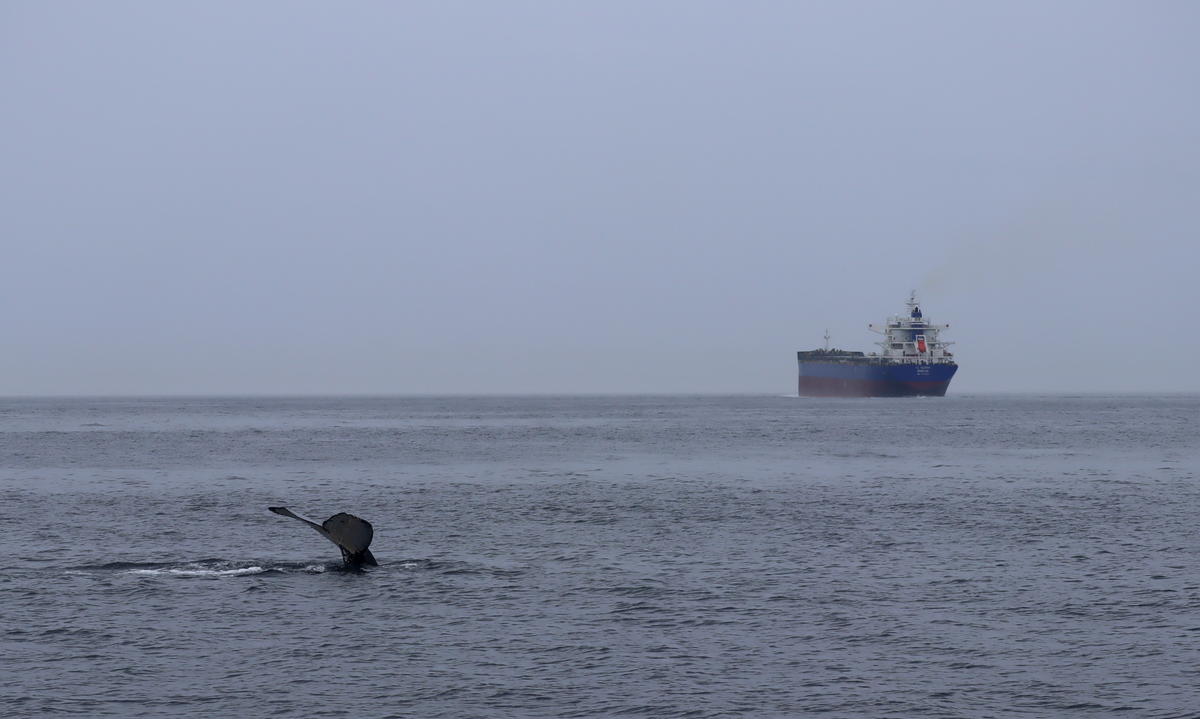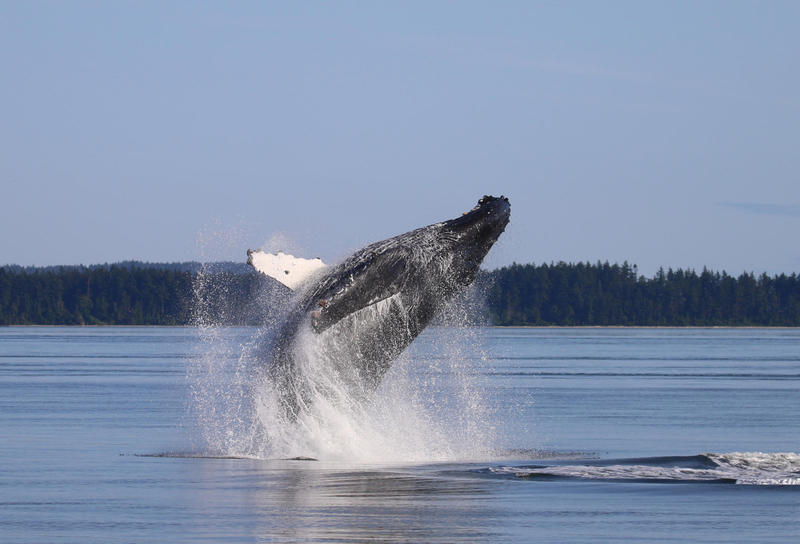The resurgence even has a catchy moniker: the "humpback comeback." When I booked a whale watching tour from Port Angeles earlier this month, Island Adventures lead naturalist Erin Gless said I'd have a 92 percent chance of seeing these large whales.
Sure enough, after the Island Explorer 4 motored out into the Strait of Juan de Fuca, the onboard naturalist grabbed her microphone to announce, "Thar she blows! 10 o'clock, 10 o'clock."
Tour guests crowded the boat's rails and followed the directional pointer to see a humpback surface with a steamy exhalation, rest for a minute and then dive again. Then the captain spotted another. The vessel cruised onward and found yet another humpback, then several more and then a pair swimming together, provoking whoops of excitement from the observers.
"We definitely had whale soup out there today," marine naturalist Renee Beitzel said at the end of the day.
Humpbacks are a favorite of whale watchers because they make showy dives and sometimes jump out of the water or slap the surface with their long pectoral fins. Beitzel said if guests had booked this same tour six or seven years ago, they probably would not have seen any humpbacks.
"It's a very different contrast to back in 2012-2013," Beitzel told public radio. "Now we're seeing humpbacks every day, where back then we weren't seeing many at all. We were lucky if we saw one."
Multiple studies are underway to quantify the dramatic upswing in humpbacks in Northwest waters, to figure out where they are coming from, what they're eating and what areas they use the most.
Hanna Miller, a University of Washington marine affairs graduate student, hitched a ride on the whale watch boat Saturday to document each sighting for an ongoing whale survey overseen by the Olympia-based Cascadia Research Collective.
"I will try to take a photo of the tail fluke. That's how you ID," Miller explained. "And then I'll try to get a left and a right dorsal fin photo. That's another way to ID."
The vessel crew also had a pole tool akin to a pool skimmer at the ready in case someone spotted humpback poop. A University of Victoria researcher put a call out for fecal samples to analyze specifically what the whales are eating locally.
The humpbacks repopulating Pacific Northwest waters are seasonal visitors. The identification photos show they migrate from winter breeding and calving grounds in Hawaii or Mexico to feed up here in summer and fall on krill and schools of little fish — such as herring, sardines, sand lances and smelt.
Whale expert John Calambokidis of Cascadia Research has studied humpback whales in the Pacific for decades. He said the repopulation of the Northwest's inside waters by the large whales, while exciting, does expose them to increased risk of ship strikes and entanglement in fishing gear.
"Both of these threats, the entanglements and the ship strikes, are areas where there are efforts to try to reduce it," Calambokidis said. "I think in some cases progress is a little too slow."

Several humpbacks whales have washed ashore dead along the West Coast this year and last after getting completely tangled in ropes from crab pots. Then there was that surprising and probably fatal collision near dowwntown Seattle this spring between a Washington State Ferry and a young humpback whale.
All humpback whales were listed as endangered by the United States in 1970. Since then, some breeding populations, including the Hawaiian group, have rebounded enough to warrant delisting. The group that winters off the Pacific Coast of Mexico was upgraded from endangered to threatened status in 2016.
For now, the humpback comeback gives whale watchers something to enjoy while the previous main attraction — the Puget Sound's southern resident killer whales — are largely absent.
"I think it's fantastic that they're finding their way back to the area," said Robert Detorres of Sunnyside, Yakima County.
"It's just amazing," added fellow whale watcher Deanna Butcher of Port Angeles. "Especially the humpbacks, they eat some of the smallest things and they're some of the biggest creatures. It's just awe-inspiring seeing them every time. It takes your breath away."
In a Facebook post on Tuesday, the Island Adventures whale watching company said its crew misses seeing the dwindling population of endangered southern resident killer whales, which are spending more time in remote offshore waters where there seems to be more of their favorite chinook salmon prey.
"We're being asked nearly daily in emails, phone calls and by guests visiting our shops, 'Are you even seeing whales anymore?' " the whale watching company said. "Quite honestly, we have never had more whales in the Salish Sea and have seen whales on 99% of our tours so far in 2019. When we explain this to those asking, we find that we're met with disbelief."
Along with the humpback comeback, greater numbers of transient orcas — aka Bigg's killer whales — are being sighted in the Salish Sea. Beitzel, the marine naturalist, said the Bigg's killer whales will occasionally harass the much larger humpbacks. The marine mammal-eating killer whales are capable of taking a humpback calf, but Beitzel said she personally had not seen that happen in Washington waters.
Humpback whales get their name from the distinctive hump they show when they arch their backs to begin a dive. Fully grown adults reach an impressive size of up to 40 tons and 60 feet in length.
This story was originally published on the NW News Network.



